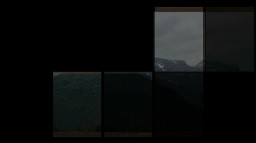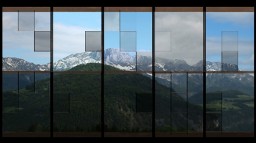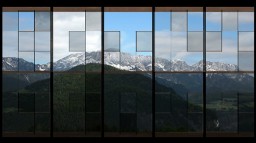Ősz Gábor
- The Window / sequence detail
- The Window / sequence detail
- The Window / sequence detail
- The Window / sequence detail
Das Fenster / The Window
While I was preparing for the realisation of the film “Das Fenster”, I often browsed the internet for relevant webpages. This is how I came across post-War photographs, probably taken by tourists, before the building was blown up in 1952. Maybe the reason they kindled my interest was that in this dark burnt-out locale, where once there was a window, now gaped an enormous rectangular hole, giving a strong radiant focus to this landscape framed in concrete. In this way, it was quite conceivable what Hitler meant when he said that the building was, in fact, constructed around the window. It seemed like the panoramic scenery itself was a picture, a projected image. It was not only suggested by the dark surroundings around the window, but the proportions of the window itself also reinforced the illusion of the movie theatre. It is well known that Hitler, like so many other dictators, loved movies. Thus, it may not come as a surprise that beside the movie-like format suggested by the window, a real movie screen was also included in the space. In the post-War pictures on the right side of the window we can clearly see the holes, behind which the hidden projectors were concealed. The great hall may rightfully be called the machinery of a systematically arranged spectacle.
Measuring four by eight metres, the panorama window was the central feature of the room, not only because of its size, but also on account of the impressive view it offered. The window opened directly onto Obersalzberg’s famous mountain, the Unterberg. The mystic aura surrounding this mountain dates back to mediaeval times. It was on account of the mountain that Obersalzberg became the summer residence of Bavarian kings.
Hitler always had a fascination for German mythology and the tales of great German conquerors alike. The mythical German history of the mountain constituted a reference frame for both the location of the Berghof and the windows themselves. He attributed magical powers to the mountain, regarding it as a great resource for ultimate victory. He seized it in the form of a political manifesto, wishing to exercise control and power over the landscape.
Gábor Ősz



